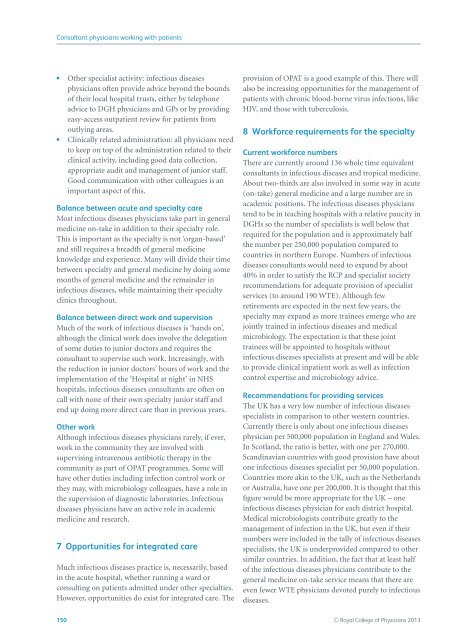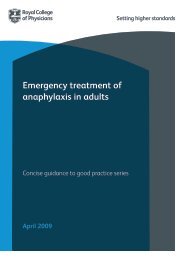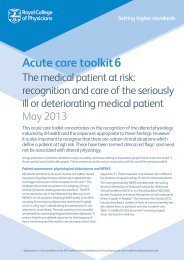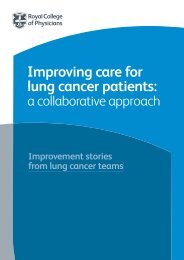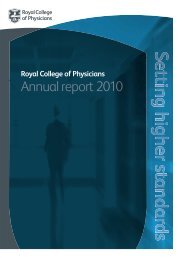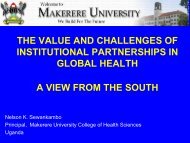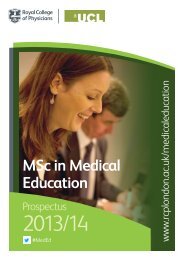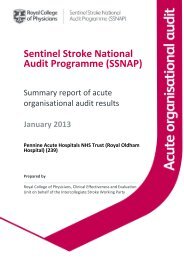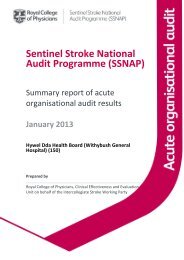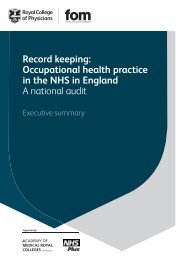Consultant physicians working with patients - Royal College of ...
Consultant physicians working with patients - Royal College of ...
Consultant physicians working with patients - Royal College of ...
You also want an ePaper? Increase the reach of your titles
YUMPU automatically turns print PDFs into web optimized ePapers that Google loves.
<strong>Consultant</strong> <strong>physicians</strong> <strong>working</strong> <strong>with</strong> <strong>patients</strong> Other specialist activity: infectious diseases<strong>physicians</strong> <strong>of</strong>ten provide advice beyond the bounds<strong>of</strong> their local hospital trusts, either by telephoneadvice to DGH <strong>physicians</strong> and GPs or by providingeasy-access outpatient review for <strong>patients</strong> fromoutlying areas. Clinically related administration: all <strong>physicians</strong> needto keep on top <strong>of</strong> the administration related to theirclinical activity, including good data collection,appropriate audit and management <strong>of</strong> junior staff.Good communication <strong>with</strong> other colleagues is animportant aspect <strong>of</strong> this.Balance between acute and specialty careMost infectious diseases <strong>physicians</strong> take part in generalmedicine on-take in addition to their specialty role.This is important as the specialty is not ‘organ-based’and still requires a breadth <strong>of</strong> general medicineknowledge and experience. Many will divide their timebetween specialty and general medicine by doing somemonths <strong>of</strong> general medicine and the remainder ininfectious diseases, while maintaining their specialtyclinics throughout.Balance between direct work and supervisionMuch <strong>of</strong> the work <strong>of</strong> infectious diseases is ‘hands on’,although the clinical work does involve the delegation<strong>of</strong> some duties to junior doctors and requires theconsultant to supervise such work. Increasingly, <strong>with</strong>the reduction in junior doctors’ hours <strong>of</strong> work and theimplementation <strong>of</strong> the ‘Hospital at night’ in NHShospitals, infectious diseases consultants are <strong>of</strong>ten oncall <strong>with</strong> none <strong>of</strong> their own specialty junior staff andend up doing more direct care than in previous years.Other workAlthough infectious diseases <strong>physicians</strong> rarely, if ever,work in the community they are involved <strong>with</strong>supervising intravenous antibiotic therapy in thecommunity as part <strong>of</strong> OPAT programmes. Some willhave other duties including infection control work orthey may, <strong>with</strong> microbiology colleagues, have a role inthe supervision <strong>of</strong> diagnostic laboratories. Infectiousdiseases <strong>physicians</strong> have an active role in academicmedicine and research.7 Opportunities for integrated careMuch infectious diseases practice is, necessarily, basedin the acute hospital, whether running a ward orconsulting on <strong>patients</strong> admitted under other specialties.However, opportunities do exist for integrated care. Theprovision <strong>of</strong> OPAT is a good example <strong>of</strong> this. There willalso be increasing opportunities for the management <strong>of</strong><strong>patients</strong> <strong>with</strong> chronic blood-borne virus infections, likeHIV, and those <strong>with</strong> tuberculosis.8 Workforce requirements for the specialtyCurrent workforce numbersThere are currently around 136 whole time equivalentconsultants in infectious diseases and tropical medicine.About two-thirds are also involved in some way in acute(on-take) general medicine and a large number are inacademic positions. The infectious diseases <strong>physicians</strong>tend to be in teaching hospitals <strong>with</strong> a relative paucity inDGHs so the number <strong>of</strong> specialists is well below thatrequired for the population and is approximately halfthe number per 250,000 population compared tocountries in northern Europe. Numbers <strong>of</strong> infectiousdiseases consultants would need to expand by about40% in order to satisfy the RCP and specialist societyrecommendations for adequate provision <strong>of</strong> specialistservices (to around 190 WTE). Although fewretirements are expected in the next few years, thespecialty may expand as more trainees emerge who arejointly trained in infectious diseases and medicalmicrobiology. The expectation is that these jointtrainees will be appointed to hospitals <strong>with</strong>outinfectious diseases specialists at present and will be ableto provide clinical inpatient work as well as infectioncontrol expertise and microbiology advice.Recommendations for providing servicesThe UK has a very low number <strong>of</strong> infectious diseasesspecialists in comparison to other western countries.Currently there is only about one infectious diseasesphysician per 500,000 population in England and Wales.In Scotland, the ratio is better, <strong>with</strong> one per 270,000.Scandinavian countries <strong>with</strong> good provision have aboutone infectious diseases specialist per 50,000 population.Countries more akin to the UK, such as the Netherlandsor Australia, have one per 200,000. It is thought that thisfigure would be more appropriate for the UK – oneinfectious diseases physician for each district hospital.Medical microbiologists contribute greatly to themanagement <strong>of</strong> infection in the UK, but even if theirnumbers were included in the tally <strong>of</strong> infectious diseasesspecialists, the UK is underprovided compared to othersimilar countries. In addition, the fact that at least half<strong>of</strong> the infectious diseases <strong>physicians</strong> contribute to thegeneral medicine on-take service means that there areeven fewer WTE <strong>physicians</strong> devoted purely to infectiousdiseases.150 C○ <strong>Royal</strong> <strong>College</strong> <strong>of</strong> Physicians 2013


